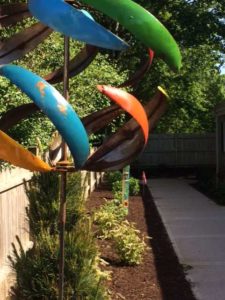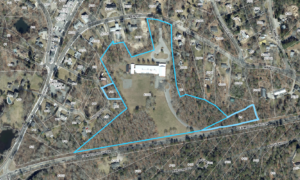 By Penny D Majike, Rosewood Manor
By Penny D Majike, Rosewood Manor
A Therapeutic garden can be designed for many different purposes. Among the many types would be gardens for shelters, veterans, hospice, psychiatric facilities, for the deaf or blind, and also for Dementia and Alzheimer’s patients. The healing component targets the specific need and promotes a feeling of wellbeing.
Beth Couet, of Beth Couet Designs, created the new therapeutic memory garden at Rosewood Manor to benefit residents who have memory loss and dementia. With the help of staff and present and former resident families, the garden miraculously took shape over a weekend in June.
I sat with Beth to find out what goes into the planning and implementation of a therapeutic memory garden. She outlined some of the basic components for me.
1. The garden needs to be close to the building so that it is visible both inside and out.
2. It needs to provide features that stimulate memories and lets residents become engaged in meaningful outdoor activities such as tending raised vegetable beds, filling birdfeeders, sweeping, and harvesting, to name a few.
3. The view should face away from roads and parking lots.
4. There should be areas of shade in the garden as elderly residents can overheat quickly.
5. Exterior gates should be disguised so that it is not apparent that they are gates.
6. Avoid plants or statuary that could possibly evoke fear, like gargoyles or trees that loom over walkways.
7. Provide a water feature – the sound of water fountains is very calming.
8. All plant material and mulch must be non-toxic.
So many details were carefully considered while designing this amazing space. Even the concrete was dyed to provide a non-glare surface.
The garden Beth designed for Rosewood has five vignettes to stimulate memories and conversation.
The first area you come upon is the “seasons.” Here, plants were chosen to represent the four seasons. One of the goals of the memory garden is to help orient residents to times of the day and seasons of the year. The feature plants chosen for this section were a spring blooming magnolia, a summer blooming Japanese Stewartia, an Autumn Brilliance Serviceberry, and a Korean Silver Fir.
The second area is “memories of gardens past,” an ode to old-fashioned Cape Cod gardens. The plants chosen for this section were thornless roses, old-fashioned Abelia, dwarf Rose of Sharon, Lambs Ears, and Meadow Sage. This area is also a sensory area with the fragrance of the roses, the soft touch of the lambs ears and the color of the brilliant purple meadow sage.
The third vignette is a Japanese-inspired garden anchored by a dwarf Japanese Maple. Other elements include Spirea, Soft touch pines, and a large blue ceramic Koi fish.
The fourth area is the woodland garden. This features native shrubs and shade perennials like hosta and Astilbe.
The fifth and final planting area is the herb and vegetable garden. The herbs planted along a walkway were picked because they release a scent when you brush by them. The vegetables will be in wheelchair-height planting beds so that residents can easily tend them. There is also a bed of blueberries for residents to enjoy.
In addition to the plantings, the management team made a road trip to the Brimfield Antique Fair to find unique items to incorporate. There is an antique plow for the vegetable area, a hand pump from an old well will become a water feature. An old potting bench was purchased for residents to use, as well as birdhouses and other unique finds.
Penny Majike is the Director of Marketing and Admissions for Rosewood Manor
Sponsored Content























